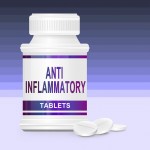
Depression has been studied from many different angles and conclusive evidence suggests that there are likely to be several biological domains involved.
More recently, people have started getting excited by possible deregulation of the immune system in depression. For instance, there are studies that have found higher levels of pro-inflammatory substances in the blood of people with depression and some report that anti-inflammatory drugs may help alleviate symptoms (Dantzer, O’Connor, Freund, Johnson, & Kelley, 2008).
However, to date there are hardly any state-of-the-art meta-analyses that systematically review the efficacy and safety of such drugs in the treatment of depression. To heat up the debate, Köhler et al. (2014) have recently published a paper that has taken a look at this issue.
Methods
The authors screened major medical databases for randomised, placebo-controlled trials that evaluated efficacy and tolerability of anti-inflammatory drugs on both clinically diagnosed depression as well as depressive symptoms. Pooled standard mean differences (SMD), odds ratios (ORs) and 95% confidence intervals (95% CI) are provided.

We all feel tired and irritable when we have viral or bacterial infections, but for some people this can lead to a more serious episode of clinical depression.
Results
Overall, 10 publications based on 14 trials (including a total of 6,262 participants) without psychiatric comorbidities were eligible for inclusion. Of those:
- 10 trials investigated non-steroidal anti-inflammatory drugs (NSAID, 4,258 participants)
- 4 trials assessed cytokine inhibitors (2,004 participants)
There was a high risk of bias (e.g. inadequate blinding) in all studies and this casts a long shadow on the results section. Only 1 study provided dichotomous information on response and was not included in SMD calculations.
- There was high heterogeneity among primary studies and a generally high risk of bias
- Four out of ten trials used NSAIDs as an add-on therapy (combined with serotonergic or noadrenergic drugs) and cytokine inhibitors were the only pharmacological treatment in all four studies
- Compared to placebo, any kind of anti-inflammatory drug treatment significantly reduced depressive symptoms (SMD -0.34; 95% CI -0.57 to -0.11)
- This was the case for both clinically diagnosed depression (SMD -0.54, 95% CI -1.08 to -0.01) and sub-clinical depressive symptoms (SMD -0.27, 95% CI -0.53 to -0.01)
- A similar superiority of anti-inflammatory treatment over placebo was also noted in terms of response (OR 2.41, 95% CI, 1.12 to 5.2) and remission (OR 2.73, 95% CI 1.37 to 5.46)
- NSAIDs (SEM -0.27, 95% CI -0.45 to -0.08) and cytokine inhibitors (SEM -0.38, 95% CI -0.88 to 0.12) did not differ in their antidepressant effects (p= 0.67), but only NSAIDs were significantly more effective than placebo
- Only six studies investigated adverse effects, but found no increased number of common occurrences like gastrointestinal (OR 1.04, 95% CI 0.61 to 1.79) or cardiovascular events (OR 2.0, 95% CI 0.25 to 16.08) of either NSAIDs or cytokine inhibitors compared to placebo
- Add-on celecoxib, a popular NSAID, was associated with a higher response (OR 6.59, 95% CI 2.24 to 19.42) and remission (OR 7.89, 95% CI 2.94 to 21.17) when compared with placebo

The studies included in this review all suffered from inadequate blinding.
Limitations
Overall, the conclusions of this meta-analysis suffer from several draw-backs:
- Not all studies report adverse effects and in addition, treatment duration was restricted to 6-12 weeks, which might have been too short to detect more long-term (adverse) effects. As previous studies have warned of significant health threats associated with prolonged NSAID treatment, future studies will need to incorporate longer durations
- All studies have a high risk of bias which threatens internal validity and might have inflated efficacy estimations. For instance, the authors suggest a for-profit bias in 12 of the 14 studies
- What is more, publication bias might have been at work
Summary
The study concludes that:
…anti-inflammatory treatment, in particular celecoxib, decreases depressive symptoms without increased risk of adverse effects.
Conclusion
This meta-analysis reports that easily available anti-inflammatory drug treatment (more NSAIDs and less cytokine inhibitors) can have antidepressant effects either on their own or as add-on to standard drug therapy. However, while it seems these drugs are generally well tolerated in the short-term, longer studies are needed to provide adequate safety data.
As the authors suggest, subgroups of patients with raised inflammatory markers or somatic comorbitidies may particularly benefit from such treatment. Specifically, celecoxib may prove to be a useful addition to antidepressant treatment, but more “unbiased” studies are needed to corroborate such an effect.
To what extent these findings will translate into improved patient care, however, depends on careful discussion with health practitioners and patients. Given the high effect sizes reported here, there is some stimulus for further investigation.

This review gives practitioners and researchers something to think about, but more better quality studies are needed before we can use this evidence in practice.
Links
Köhler, O., Benros, M. E., Nordentoft, M., Farkouh, M. E., Iyengar, R. L., Mors, O., & Krogh, J. (2014). Effect of Anti-inflammatory Treatment on Depression, Depressive Symptoms, and Adverse Effects. JAMA Psychiatry. doi:10.1001/jamapsychiatry.2014.1611 [PubMed abstract]
Dantzer, R., O’Connor, J. C., Freund, G. G., Johnson, R. W., & Kelley, K. W. (2008). From inflammation to sickness and depression: when the immune system subjugates the brain. Nature Reviews. Neuroscience, 9, 46–56. doi:10.1038/nrn2297


RT @Mental_Elf: Anti-inflammatory drugs for depression: new review points to benefits, but more research needed http://t.co/v4mfM3Dj4w
Brendon Stubbs liked this on Facebook.
Olivia Cialdi liked this on Facebook.
Helge Ha liked this on Facebook.
Shelley Louise liked this on Facebook.
Princess Sunshyne liked this on Facebook.
Today we highlight a @JAMAPsych study on the effect of anti-inflammatory treatment for depression http://t.co/bDwQGrbyeW
@Mental_Elf any research on effective talking therapies for deaf adolescents?
@Mental_Elf SSRIS cause GI bleeding in some and of course NSAIDS big cause of GI bleeding so side effects would be a concern
@SameiHuda @Mental_Elf in my experience treating patients, NSAIDs have depression as side effect, fairly often.
@HombreDeBicycle @Mental_Elf that’s very interesting
@HombreDeBicycle @Mental_Elf Wow! Would never have suspected this.
@HombreDeBicycle @Mental_Elf reflecting if similar experience could also be linked to what I was put on NSAID s for? #ankylosingspondylitis
‘Sue Mario liked this on Facebook.
June Dunnett liked this on Facebook.
This area is going to grow rapidly: Anti-inflammatory treatments for depression. http://t.co/8pG2ozEcQb
Anti-inflammatory drugs for depression: new review points to benefits: http://t.co/HYAAX5oCuh @MEAssociation for interest #ME #CFS
Could NSAIDs be a safe and effective treatment for depression? http://t.co/bDwQGrbyeW
Meta-Analysis shows that anti-inflammatory drugs can have #antidepressant effects in short-term use! http://t.co/1fWub82EPw via @Mental_Elf
Mental Elf: Anti-inflammatory drugs for depression: new review points to benefits, but more research needed http://t.co/XeumZ3ZnEz
Irene Trilla liked this on Facebook.
Don’t miss – Anti-inflammatory drugs for depression: new review points to benefits, but more research needed http://t.co/bDwQGrbyeW
@Mental_Elf
Interesting study, but further exploration is clearly needed due to the limitations, lack of blinding & high risk of bias!
I found that magnesium and potarium almost all but ended my depression. Now i just have to deal with the extreme pain and diseeffects from the over 50 ears of pharm drugs. I advise people get you vitmain and suppliement levels checked.
Clarissa Crader liked this on Facebook.
A systematic review of anti-inflammatory drugs for depression http://t.co/BBGKYSAWY2
Anti-inflammatory drugs for depression? http://t.co/qwTZFFPc2M
“Anti-inflammatory drugs for depression” http://t.co/OZK3ExhUas
[…] The Mental Elf (2015) Anti-inflammatory drugs for depression: new review points to benefits, but more research needed […]